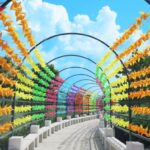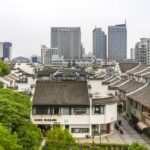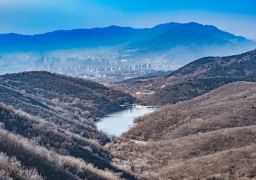Yingjiang Temple majestically stands on the eastern edge of the city by the great river. Historically known as HuGuo Yongchang Zen Temple, it is also referred to as the Ten Thousand Buddhas Temple. It was originally constructed in the seventh year of the Kaibao era during the Northern Song Dynasty (974). In the forty-seventh year of the Wanli era (1619), local gentleman Ruan Zihua raised funds to renovate it. The temple, with its magnificent halls and grand presence, has become a famous Buddhist temple along the river.
A guide to visiting: The temple is composed of a complex of ancient architectural structures including halls, chambers, pavilions, buildings, towers, and gardens, covering an area of 22,000 square meters. The riverside mountain gate is inscribed with three regular script golden characters ‘Yingjiang Temple’ handwritten by Emperor Guangxu, which are robust and radiant. On the white marble gate ticket, there is a relief of a four-clawed divine dragon. On both sides of the gate, there are placed large iron anchors, weighing about 3 tons, which are unique to this temple. According to folklore, the terrain of Anqing is like a ship, the tower is the mast, and without the anchors to secure it, Anqing city would drift eastward with the river, hence their installation. Upon entering the mountain gate, one encounters the Hall of the Heavenly Kings where Maitreya Buddha sits in the niche, with the Four Heavenly Kings standing on either side, each with a different expression. Ascending 28 steps leads to the Mahavira Hall with a plaque inscribed by Zhao Puchu. Behind it is the Vairocana Hall, where the divine Buddha Vairocana and the two great heavenly kings, Indra and Maha Brahma, are solemnly seated in the hall. Behind the hall, there is a group sculpture of the Four Sea Dragon Kings paying homage to Guanyin. The fourth hall is the Sutra Repository, which houses treasures such as the ‘Lotus Sutra’ bestowed by Emperor Guangxu of the Ming Dynasty and a sketch of Guanyin Bodhisattva. The temple houses nearly 500 statues of gods and Buddhas, as well as golden plaques bestowed by Emperor Qianlong and Empress Dowager Cixi, titled ‘Good Lion’s Roar’ and ‘Wondrous Bright Mirror’. The temple is open all day, every day of the year, with specific business hours subject to the daily opening conditions.Yingjiang Temple
Yingjiang Temple majestically stands on the eastern edge of the city by the great river. Historicall[...]









